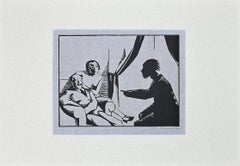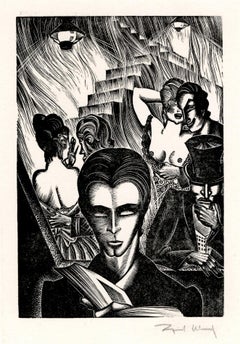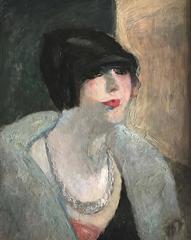René Georges Hermann-Paul Art
to
1
1
1
Overall Height
to
Overall Width
to
1
1
1
1
1
1
1
1
6,958
3,340
2,513
1,213
1
1
Artist: René Georges Hermann-Paul
The Visit - Original Woodcut Print on Paper - 1925
By René Georges Hermann-Paul
Located in Roma, IT
The Visit is an original Modern Artwork realized in the 1920s by the French artist René Georges Hermann-Paul (1864 – 1940).
Original B/W woodcut print on paper.
Hand-signed in penc...
Category
1920s Modern René Georges Hermann-Paul Art
Materials
Woodcut, Paper
Related Items
'Madman's Drum (Plate 41)' — 1930s Graphic Modernism
By Lynd Ward
Located in Myrtle Beach, SC
Lynd Ward, 'Madman's Drum, Plate 41', wood engraving, 1930, edition small. Signed in pencil. A fine, black impression, on off-white tissue-thin Japan paper; the full sheet with margins (1 5/8 to 2 1/2 inches); a small paper blemish in the upper right margin, away from the image, otherwise in excellent condition. Scarce. Matted to museum standards, unframed.
Image size 5 1/2 x 3 3/4 inches (140 x 95 mm); sheet size 9 5/8 x 7 1/8 inches (244 x 181 mm).
From Lynd Ward’s book of illustrations without words, 'Madman’s Drum', Jonathan Cape and Harrison Smith, New York, 1930. Illustrated in 'Storyteller Without Words: The Wood Engravings of Lynd Ward', Harry Abrams, New York, 1974.
Reproduced in 'Storyteller Without Words, the Wood Engravings of Lynd Ward', Harry N. Abrams, New York, 1974.
ABOUT THE ARTIST
Lynd Ward is acknowledged as one of America’s foremost wood engravers and book illustrators of the first half of the twentieth century. His innovative use of narrative printmaking as a stand-alone storytelling vehicle was uniquely successful in reaching a broad audience. The powerful psychological intensity of his work, celebrated for its dynamic design, technical precision, and compelling dramatic content, finds resonance in the literature of Poe, Melville, and Hawthorne. Like these classic American writers, Ward was concerned with the themes of man’s inner struggles and the role of the subconscious in determining his destiny. An artist of social conscience during the Great Depression and World War II, he infused his graphic images with his unique brand of social realism, deftly portraying the problems that challenged the ideals of American society.
The son of a Methodist preacher, Lynd Ward, moved from Chicago to Massachusetts at an early age. He graduated from the Teachers College of Columbia University, New York, in 1926, where he studied illustration and graphic arts. He married May Yonge McNeer in 1936 and left for Europe for their honeymoon in Eastern Europe. After four months, they settled in Leipzig, where Ward studied at the National Academy of Graphic Arts and Bookmaking. Inspired by Belgian expressionist artist Frans Masereel's graphic novel ‘The Sun,’ and another graphic novel by the German artist Otto Nückel, ‘Destiny,’ he determined to create his own "wordless" novel. Upon his return to America, Ward completed his first book, ‘God's Man: A Novel in Woodcuts,’ published in 1929. ‘Gods’ Man’ was a great success for its author and publisher and was reprinted four times in 1930, including a British edition. This book and several which followed it, ‘Madman’s Drum,’ 1930, ‘Wild Pilgrimage...
Category
1930s American Modern René Georges Hermann-Paul Art
Materials
Woodcut
'Simplicius' Farewell to the World' — Graphic Modernism
By Fritz Eichenberg
Located in Myrtle Beach, SC
Fritz Eichenberg, 'Simplicius’ Farewell To The World' from the suite 'The Adventurous Simplicissimus', wood engraving, 1977, artist's proof apart from the edition of 50. Signed in pencil. Signed in the block, lower right. A fine, richly-inked impression, on cream wove paper, with full margins (1 1/2 to 2 inches), in excellent condition. Image size 14 x 12 inches (356 x 305 mm); sheet size 17 1/2 x 15 inches (445 x 381 mm). Archivally sleeved, unmatted.
ABOUT THIS WORK
'Simplicius Simplicissimus' (German: Der abenteuerliche Simplicissimus Teutsch) is a picaresque novel of the lower Baroque style, written in five books by Hans Jakob Christoffel von Grimmelshausen published in 1668, with the sequel Continuatio appearing in 1669.
The novel is told from the perspective of its protagonist Simplicius, a rogue or picaro typical of the picaresque novel, as he traverses the tumultuous world of the Holy Roman Empire during the Thirty Years' War. Raised by a peasant family, he is separated from his home by foraging dragoons. He is adopted by a hermit living in the forest, who teaches him to read and introduces him to religion. The hermit also gives Simplicius his name because he is so simple that he does not know his own name. After the death of the hermit, Simplicius must fend for himself. He is conscripted at a young age into service and, from there, embarks on years of foraging, military triumph, wealth, prostitution, disease, bourgeois domestic life, and travels to Russia, France, and an alternate world inhabited by mermen. The novel ends with Simplicius turning to a life of hermitage, denouncing the world as corrupt.
ABOUT THE ARTIST
Fritz Eichenberg (1901–1990) was a German-American illustrator and arts educator who worked primarily in wood engraving. His best-known works were concerned with religion, social justice, and nonviolence.
Eichenberg was born to a Jewish family in Cologne, Germany, where the destruction of World War I helped to shape his anti-war sentiments. He worked as a printer's apprentice and studied at the Municipal School of Applied Arts in Cologne and the Academy of Graphic Arts in Leipzig, where he studied under Hugo Steiner-Prag. In 1923 he moved to Berlin to begin his career as an artist, producing illustrations for books and newspapers. In his newspaper and magazine work, Eichenberg was politically outspoken and sometimes wrote and illustrated his reporting.
In 1933, the rise of Adolf Hitler drove Eichenberg, who was a public critic of the Nazis, to emigrate with his wife and children to the United States. He settled in New York City, where he lived most of his life. He worked in the WPA Federal Arts Project and was a member of the Society of American Graphic Artists.
In his prolific career as a book illustrator, Eichenberg portrayed many forms of literature but specialized in works with elements of extreme spiritual and emotional conflict, fantasy, or social satire. Over his long career, Eichenberg was commissioned to illustrate more than 100 classics by publishers in the United States and abroad, including works by renowned authors Dostoyevsky, Tolstoy, Charlotte and Emily Brontë, Poe, Swift, and Grimmelshausen. He also wrote and illustrated books of folklore and children's stories.
Eichenberg was a long-time contributor to the progressive magazine The Nation, his illustrations appearing between 1930 and 1980. Eichenberg’s work has been featured by such esteemed publishers as The Heritage Club, Random House, Book of the Month Club, The Limited Editions Club, Kingsport Press, Aquarius Press, and Doubleday.
Raised in a non-religious family, Eichenberg had been attracted to Taoism as a child. Following his wife's unexpected death in 1937, he turned briefly to Zen Buddhist meditation, then joined the Religious Society of Friends in 1940. Though he remained a Quaker until his death, Eichenberg was also associated with Catholic charity work through his friendship with Dorothy Day...
Category
1970s American Modern René Georges Hermann-Paul Art
Materials
Woodcut
'The Pimp' — Graphic Modernism
By Fritz Eichenberg
Located in Myrtle Beach, SC
Fritz Eichenberg, 'The Pimp', wood engraving, 1980, artist's proof before the edition. Signed in pencil. Signed in the block, lower right. A fine, richly-inked impression, on cream wove paper, with full margins (2 3/16 to 3 1/2 inches), in excellent condition. Archivally sleeved, unmatted.
Image size 12 x 9 3/4 inches (305 x 248 mm); sheet size 18 x 14 inches (457 x 356 mm).
ABOUT THE ARTIST
Fritz Eichenberg (1901–1990) was a German-American illustrator and arts educator who worked primarily in wood engraving. His best-known works were concerned with religion, social justice, and nonviolence.
Eichenberg was born to a Jewish family in Cologne, Germany, where the destruction of World War I helped to shape his anti-war sentiments. He worked as a printer's apprentice and studied at the Municipal School of Applied Arts in Cologne and the Academy of Graphic Arts in Leipzig, where he studied under Hugo Steiner-Prag. In 1923 he moved to Berlin to begin his career as an artist, producing illustrations for books and newspapers. In his newspaper and magazine work, Eichenberg was politically outspoken and sometimes wrote and illustrated his reporting.
In 1933, the rise of Adolf Hitler drove Eichenberg, who was a public critic of the Nazis, to emigrate with his wife and children to the United States. He settled in New York City, where he lived most of his life. He worked in the WPA Federal Arts Project and was a member of the Society of American Graphic Artists.
In his prolific career as a book illustrator, Eichenberg portrayed many forms of literature but specialized in works with elements of extreme spiritual and emotional conflict, fantasy, or social satire. Over his long career, Eichenberg was commissioned to illustrate more than 100 classics by publishers in the United States and abroad, including works by renowned authors Dostoyevsky, Tolstoy, Charlotte and Emily Brontë, Poe, Swift, and Grimmelshausen. He also wrote and illustrated books of folklore and children's stories.
Eichenberg was a long-time contributor to the progressive magazine The Nation, his illustrations appearing between 1930 and 1980. Eichenberg’s work has been featured by such esteemed publishers as The Heritage Club, Random House, Book of the Month Club, The Limited Editions Club, Kingsport Press, Aquarius Press, and Doubleday.
Raised in a non-religious family, Eichenberg had been attracted to Taoism as a child. Following his wife's unexpected death in 1937, he turned briefly to Zen Buddhist meditation, then joined the Religious Society of Friends in 1940. Though he remained a Quaker until his death, Eichenberg was also associated with Catholic charity work through his friendship with Dorothy Day...
Category
1980s American Modern René Georges Hermann-Paul Art
Materials
Woodcut
Irving Amen, The Heart is a Garden, Signed A/P & Framed Woodblock Print
By Irving Amen
Located in Plainview, NY
A woodblock print in color, of a girl looking up at a giant flower bouquet by Irving Amen ( American, 1918-2011) . The lithograph entitled "The Heart is a Garden " is signed Amen and...
Category
20th Century Modern René Georges Hermann-Paul Art
Materials
Woodcut
H 34 in W 25 in D 1.5 in
3 Jewish Men Judaica Woodblock Woodcut Engraving Print Chicago 1930s WPA Artist
By Todros Geller
Located in Surfside, FL
Todros Geller (1889 – 1949) was a Jewish American artist and teacher best known as a master printmaker and a leading artist among Chicago’s art community.Geller was born in Vinnytsia, the Russian Empire (now Ukraine) in 1889.[2] He studied art in Odessa and continued his studies after moving to Montreal in 1906 where he immigrated to Canada. He married and moved to Chicago in 1918, where he studied at the School of the Art Institute of Chicago until 1923.
Geller produced paintings, woodcuts, woodcarvings, and etchings. His work focused on Jewish tradition, often including moralistic themes and social commentary, shtetl, ghetto life, and the intersection of Jewish tradition with modern-day Chicago. He regarded art as a tool for social reform and he spent a large part of his career teaching art. His work was commissioned for stained glass windows, bookplates, community centers and Yiddish and English books. He was regarded as a leader in the field of synagogue and religious art. He designed stained glass window for synagogues in Omaha, Fort Worth, Dayton, Stamford, and Chicago Heights. Over the course of his career he illustrated more than 40 books.
In addition to conducting classes in his studio, Geller was head of art at the Jewish People’s Institute (JPI), supervisor of art for the Board of Jewish Education and director of art for the College of Jewish Studies (which became the Spertus Institute for Jewish Learning and Leadership) and taught at Hull House. Many prominent Chicago artists studied drawing and painting under Geller. Geller was a source of inspiration to Aaron Bohrod and Mitchell Siporin...
Category
Early 20th Century Modern René Georges Hermann-Paul Art
Materials
Paper, Woodcut
Wedding Party
Located in Buffalo, NY
An original mid century modern woodblock print.
This work is hand signed illegibly and titled "Wedding Party".
Category
1960s Modern René Georges Hermann-Paul Art
Materials
Paper, Woodcut
Woodblock Portrait of a Woman
Located in Soquel, CA
Bold woodblock print of a woman by J. Duffy (American, 20th Century). The subject is staring directly at the viewer, creating a compelling yet delicate composition. The ink appears t...
Category
1950s Modern René Georges Hermann-Paul Art
Materials
Ink, Woodcut, Paper
Modern American Industrial Landscape
Located in Buffalo, NY
An original woodblock print dated 1965, titled "Our Town" but signed illegibly.
Category
1960s American Modern René Georges Hermann-Paul Art
Materials
Woodcut, Paper
Mid Century Modern Woodblock Print, Red Black Group of Figures, American Modern
By Margo Hoff
Located in Denver, CO
Woodblock on colored paper by Margo Hoff (1910-2008) titled 'Observers' of a black and red abstract scene with seventeen figures whose arms are in various positions, looking out at t...
Category
20th Century American Modern René Georges Hermann-Paul Art
Materials
Paper, Woodcut
H 20.5 in W 24.5 in D 0.75 in
Animals All: WHO WERE THE FIRST TO CRY NOWELL ANIMALS ALL AS IT BEFELL.
By Eric Gill
Located in Storrs, CT
Animals All: WHO WERE THE FIRST TO CRY NOWELL ANIMALS ALL AS IT BEFELL. 1916. Woodcut. Physick 51. 14 7/8 x 16 3/8 (sheet 25 x 27 ). No published edition. Printed on simili-Japan pa...
Category
Early 20th Century Modern René Georges Hermann-Paul Art
Materials
Woodcut
H 26.5 in W 28.5 in D 2 in
'City Lights' — Vintage Wood Engraving, New York City, 1934
By Fritz Eichenberg
Located in Myrtle Beach, SC
Fritz Eichenberg, 'City LIghts', wood engraving, 1934, edition 200. Signed, titled 'Lights', and annotated 'No 2/200 for Howard M. Chapin' in pencil. Initialed in the block, lower right. A fine, richly-inked black impression, on cream wove paper, with full margins (1 1/4 to 1 7/8 inches); a small loss (5/8 inch) in the top right sheet corner, well away from the image, otherwise in excellent condition. Printed by master printer Ernest Roth...
Category
1930s American Modern René Georges Hermann-Paul Art
Materials
Woodcut
Pour ce Jour, 1968 (Poèmes, #7)
By Marc Chagall
Located in Greenwich, CT
Pour ce jour (For this Day) is a woodcut on paper from Marc Chagall's Poèmes portfolio, published in 1968. The image size is 13 x 10 inches and the art is framed in an ornate, gold-t...
Category
20th Century Modern René Georges Hermann-Paul Art
Materials
Woodcut, Paper
Previously Available Items
Rene Georges Hermann-Paul (1864-1940) - Woodcut, The Grateful Veteran
By René Georges Hermann-Paul
Located in Corsham, GB
This charming woodcut design depicts two women passing flowers to a seated veteran. Signed and numbered in graphite 21/200. Marked with a studio stamp to the lower right. On laid .
Category
Early 20th Century René Georges Hermann-Paul Art
Materials
Woodcut
PORTRAIT DE FEMME
By René Georges Hermann-Paul
Located in Los Angeles, CA
RENE GEORGES HERMANN-PAUL
"PORTRAIT DE FEMME"
OIL ON CANVAS ON PANEL, SIGNED
FRANCE, C.1925
16 X 12.5 INCHES
Rene Georges Hermann-Paul
1874-1940
Hermann-Paul was born in Paris, he studied at the École des Arts Décoratifs and at the Académie Julian where he was the student of Henri Lerolle and Gustave Colin...
Category
1920s Art Deco René Georges Hermann-Paul Art
Materials
Canvas, Oil, Panel
René Georges Hermann-paul art for sale on 1stDibs.
Find a wide variety of authentic René Georges Hermann-Paul art available for sale on 1stDibs. You can also browse by medium to find art by René Georges Hermann-Paul in paper, woodcut print and more. Much of the original work by this artist or collective was created during the 1920s and is mostly associated with the modern style. Not every interior allows for large René Georges Hermann-Paul art, so small editions measuring 13 inches across are available. Customers who are interested in this artist might also find the work of Robert Bonfils, Jean Gabriel Daragnès , and Albert Besnard. René Georges Hermann-Paul art prices can differ depending upon medium, time period and other attributes. On 1stDibs, the price for these items starts at $557 and tops out at $557, while the average work can sell for $557.
Artists Similar to René Georges Hermann-Paul
Robert Sargent Austin, R.A., P.R.E., P.R.W.S.




